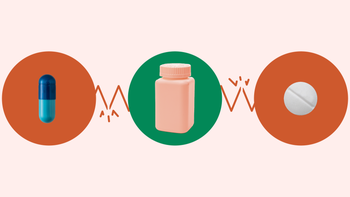
What Are the Best Deep Vein Thrombosis (DVT) Treatments and Medications?
Key takeaways:
Deep vein thrombosis (DVT) is a blood clot that forms in a vein — most often in the lower leg, thigh, or pelvis. It’s a common but potentially serious condition.
DVTs are usually treated with anticoagulant medications (blood thinners). There are other treatment options for more severe cases and people who can’t take blood thinners.
Early treatment with a blood thinner stops the clot from getting bigger and prevents complications while the body dissolves the clot.

Deep vein thrombosis (DVT) is a blood clot that forms in a vein. Every year, up to about 900,000 people in the U.S. have a DVT. This usually happens in the thigh or lower leg. But it can happen in other deep veins in the body — like the arm, chest, abdomen, or pelvis. A deep vein is simply a vein that’s deeper inside the body rather than near the skin surface.
DVTs are treatable, no matter where they are in the body. But treatment isn’t the same for all clots. It depends on the location of the DVT, your medical history, and your personal preferences.
In this article, we’ll explain treatment options for DVT in the legs specifically, since this is most common. If you have a DVT in the arm or in another part of the body, your treatment may be slightly different. But a lot of these treatments are still used.
Medications for DVT
Prescription medications often called “blood thinners” are the main treatment for a DVT.
There are several different types of blood thinners, and they work in slightly different ways. But they all prevent the DVT from getting bigger and prevent new clots from forming. This gives the body time to dissolve the DVT over time. Treatment usually lasts at least 3 months, but it may be longer for some people.
Examples of blood thinners include:
Warfarin (Coumadin): Warfarin is an older but inexpensive and effective blood thinner. People who take warfarin need regular blood tests to make sure they’re taking the right dose. Certain foods and other medications interact with warfarin, which can also affect the dose.
Direct oral anticoagulants (DOACs): DOACs are a group of newer blood thinners. They include medications like rivaroxaban (Xarelto) and apixaban (Eliquis). Sometimes they can be more expensive, depending on the insurance plan. But they don’t require blood testing to monitor the dose. This also means they don’t need frequent dose changes during treatment.
Low molecular weight heparin (LMWH): This includes enoxaparin (Lovenox), which is safe for people who are pregnant. Enoxaparin is given as an injection, which you give yourself at home.
What’s your blood clot risk? Learn about what causes a blood clot, and what conditions can increase your risk.
Comparing blood thinners: There are several different types of blood thinning medications. Our guide compares your options.
Is it a leg cramp? Sometimes, a deep vein thrombosis may feel like a simple leg cramp. We explain how you can tell the difference.
You and your healthcare team will consider many factors when deciding the best blood thinner for you — like cost, your other medical conditions, and your personal preference.
For example, some of the options are better for people who have kidney disease. Treatment also depends on your risk for bleeding, which is a serious side effect of all blood thinners. But some of the options are safer for people who have a higher risk for bleeding than others. And some people may not be able to take a blood thinner at all if their risk of bleeding is particularly high.
Procedures for DVT
Blood thinners are often the preferred treatment for DVTs, but there are also other treatments.
Thrombolytic therapy
This type of treatment uses a medication called “tissue plasminogen activator” (tPA) to break down the blood clot. This is different from a blood thinner because it can actually break down the clot. People can get tPA through an IV or a catheter a healthcare professional places inside the vein at the location of the DVT.
Thrombolytic therapy isn’t a routine treatment for a DVT because it:
Doesn’t decrease the risk of death from a DVT or of another DVT
Has a higher risk of bleeding
Requires you to be in a hospital for the treatment
Is more expensive
Healthcare professionals may recommend thrombolytic therapy for people with complicated or severe DVTs. This includes clots that are blocking blood flow to the leg, or for clots that cause severe symptoms despite treatment with blood thinners.
Thrombectomy
Thrombectomy is a procedure that physically removes the blood clot from the vein. This is done with surgery or by inserting a catheter into the vein at the location of the blood clot.
Like thrombolytic therapy, thrombectomy gets rid of the clot right away. And healthcare professionals may use these treatments together. But, like thrombolytic therapy, thrombectomy is only for severe DVTs.
IVC filter
An IVC filter is a small medical device that’s inserted into one of the body’s larger veins near the heart — the inferior vena cava (IVC). This is done to trap any blood clots traveling toward the heart and lungs, where clots can be more dangerous.
IVC filters come with risks, and most people don’t need one. But they may be an option for people who can’t take a blood thinner.
Do all DVTs need treatment?
In some cases, people and their healthcare team will decide not to treat a DVT with medication or a procedure. For example, this may be a better option for someone who has a small blood clot and a very high risk of bleeding.
It’s possible that a DVT can go away on its own. If the DVT is in the lower part of the leg (below the knee), you may be able to monitor it without treatment. And a DVT in this location has a lower risk of breaking off and traveling to the lungs.
Can you cure deep vein thrombosis?
Yes, a DVT can be cured. Most DVTs will resolve without any long-term problems. But some people may have ongoing symptoms. About 15% of people will develop a combination of chronic pain and swelling.
It’s important to know that even after they’re cured, DVTs can happen again. This means that after you’ve had one DVT, you’re at risk for developing another blood clot in the future.
The risk isn’t the same for everyone. It depends on what caused your DVT in the first place. For example, if you developed a blood clot after surgery or during pregnancy, your risk for another clot might be lower once you recover. But if you have a long-term medical condition that increases your risk — like heart disease or a blood-clotting disorder — your ongoing risk may be higher. And some people at higher risk may need to take blood thinners longer to prevent another blood clot.
How long does it take for a DVT to go away?
After you’re diagnosed with a DVT, your body will start to heal by gradually absorbing the blood clot over weeks to months. Blood thinners don’t dissolve the DVT, but they prevent the DVT from getting bigger as the body absorbs it. Any symptoms you have from the DVT will slowly go away as the clot resolves.
How serious are DVTs?
DVT is a serious condition. The biggest concern with a DVT is that a piece of the blood clot will break off and travel to the lungs. This is a pulmonary embolism (PE), which can be life-threatening. DVT and PE cause up to about 100,000 deaths every year in the U.S.
Another possible complication of DVT is post-thrombotic syndrome (PTS). PTS happens when the blood clot damages the vein and affects blood flow through the vein. For a DVT in the leg, this can lead to chronic leg pain, swelling, skin color changes, and ulcers.
The good news is that treatment helps to prevent these serious complications.
Frequently asked questions
A DVT is usually diagnosed with an ultrasound. Sometimes, before you get an ultrasound, a healthcare professional may recommend a blood test called a D-dimer. This test can measure the likelihood of a blood clot in the body.
Other tests may also be able to detect a blood clot, like a CT scan. But this isn’t a common way to diagnose a blood clot.
Drinking water helps with blood flow. Research doesn’t show that drinking extra water necessarily reduces your chances of getting a blood clot. That said, dehydration can increase your risk for a blood clot. So if you are dehydrated, drinking water will help.
You can have a DVT for a long time without knowing it. Especially if the DVT is small, or not causing any complications. One study looked at this in people who were diagnosed with a blood clot in the lungs. They found that over half the people had a blood clot in the legs at the same time, without any symptoms.
The bottom line
Deep vein thrombosis (DVT) is a serious but treatable medical condition. There are several treatment options for DVTs. The treatment that’s right for you depends on where the blood clot is, how serious it is, your overall health, and your risk for future blood clots. For most people, this means taking a blood thinning medication for several months. Your healthcare team can help you understand the risks and benefits of certain treatments to help you make the right choice.
Why trust our experts?


References
Áinle, F. N., et al. Which patients are at high risk of recurrent venous thromboembolism (deep vein thrombosis and pulmonary embolism)? Blood Advances.
Centers for Disease Control and Prevention. (2025). Data and statistics on venous thromboembolism.
Chiasakul, T., et al. (2020). Thrombolytic therapy in acute venous thromboembolism. Hematology, American Society of Hematology Education Program.
Evans, N. S., et al. (2014). Vascular disease patient information page: The post-thrombotic syndrome. Vascular Medicine.
Hirmerova, J., et al. (2018). The prevalence of concomitant deep vein thrombosis, symptomatic or asymptomatic, proximal or distal, in patients with symptomatic pulmonary embolism. Clinical and Applied Thrombosis/Hemostasis.
National Heart, Lung, and Blood Institute. (2020). Study: Death rate from lung clots is on the rise after years of decline. National Institutes of Health.
Ortel, T. L., et al. (2020). American Society of Hematology 2020 guidelines for management of venous thromboembolism: Treatment of deep vein thrombosis and pulmonary embolism. Blood Advances.
RadiologyInfo.org. (2024). IVC filters.
Stevens, S. M., et al. (2021). Antithrombotic therapy for VTE disease. Chest.
Waldron, B., et al. (2014). A patient’s guide to recovery after deep vein thrombosis or pulmonary embolism. Circulation.

























